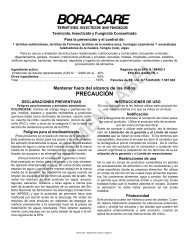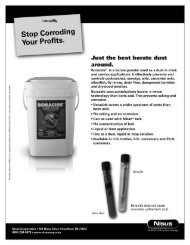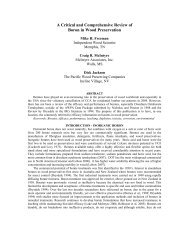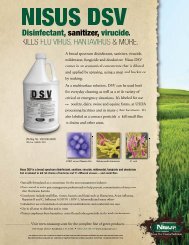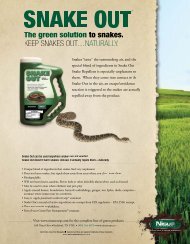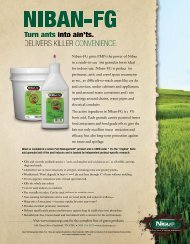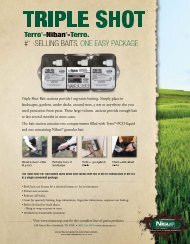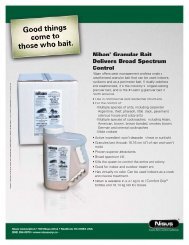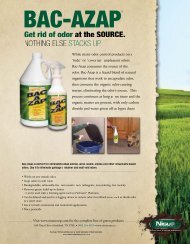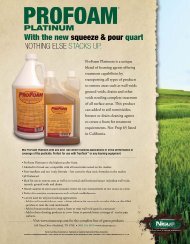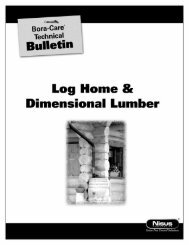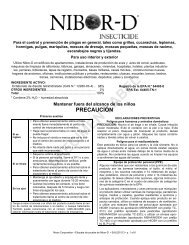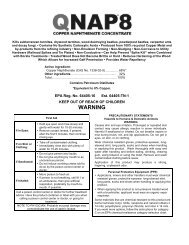NiBor-D Insecticide Label - Do My Own Pest Control
NiBor-D Insecticide Label - Do My Own Pest Control
NiBor-D Insecticide Label - Do My Own Pest Control
- No tags were found...
Create successful ePaper yourself
Turn your PDF publications into a flip-book with our unique Google optimized e-Paper software.
Nibor-D ®INSECTICIDEFor the control and prevention of general pests such asants, crickets, earwigs, roaches and silverfish.For both interior and exterior use.Use NIBOR-D in homes, restaurants, markets, schools, warehouses, factories, offices, hotels, hospitals, nursinghomes, garages, grocery stores, apartment buildings, new construction, industrial plants, theaters, ships, trains,trucks, yachts, mobile homes, buses, zoos, kennels, military bases, libraries, utilities and on railroad ties.ACTIVE INGREDIENT:Disodium Octaborate Tetrahydrate (CAS No. 12280-03-4).. 98%OTHER INGREDIENT* ..................................................... 2%TOTAL .................................................................................... 100%*Contains 2% H2o Absorbed MoistureKeep Out of Reach of ChildrenCAUTIONEPA Reg. No. 64405-8EPA Est. 64405-TN-1First AidIf Swallowed • Immediately call a poison control centeror doctor for treatment advice.• Have person sip a glass of water if ableto swallow.• <strong>Do</strong> not induce vomiting unless told to doso by the poison control center ordoctor.• <strong>Do</strong> not give anything by mouth to anunconscious person.If Inhaled • Move person to fresh air.• If person is not breathing, call 911 or anambulance, then give artificialrespiration, preferably by mouth-tomouth,if possible.• Call a poison control center or doctor forfurther treatment advice.If in Eyes • Hold eye open and rinse slowly andgently with water for 15-20 minutes.• Remove contact lenses, if present, afterthe first 5 minutes, then continue rinsingeye.• Call a poison control center or doctor forfurther treatment advice.Have the product container or label with you when calling apoison control center or doctor, or going for treatment. Youmay also contact 1-800-424-9300 for emergency medicaltreatment information.PRECAUTIONARY STATEMENTSHazards to Humans & <strong>Do</strong>mestic AnimalsCAUTION: Harmful if swallowed or inhaled. Causes moderateeye irritation. Avoid contact with eyes or clothing. Avoid breathingdust. Thoroughly wash with soap and water after handling.Remove contaminated clothing and wash clothing before reuse.Personal Protective Equipment (PPE)Some materials that are chemical-resistant to this product arebarrier laminate; butyl, nitrile, neoprene and natural rubbers ≥14 mils; polyethylene; polyvinyl chloride; and viton ≥ 14 mils. Ifyou want more options, follow the instructions for category Con an EPA chemical-resistance category selection chart.Applicators, mixers and other handlers must wear longsleevedshirt, long pants, socks, shoes, chemical-resistantgloves and protective eyewear. When applying this product inconfined spaces, provide ventilation or an exhaust system; oruse a NIOSH-approved dust/mist filtering respirator(MSHA/NIOSH approval number prefix TC-21C) with a prefilterapproved for pesticides (MSHA/NIOSH approval prefix TC-23C); or use a canister approved for pesticides (MSHA/NIOSHapproval prefix TC-14G) or a NIOSH-approved respirator withany N, R, P or HE prefilter..User Safety RequirementsFollow manufacturer’s instructions for cleaning/ maintainingPPE. If no such instructions for washables exist, use detergentand hot water. Keep and wash PPE separately from otherlaundry.
User Safety RecommendationsUsers should:Wash hands before eating, drinking, chewing gum, usingtobacco or using the toilet;Remove clothing immediately if pesticide gets inside, thenwash thoroughly and put on clean clothing;Remove PPE immediately after handling this product. Washthe outside of gloves before removing. As soon as possible,wash thoroughly and change into clean clothing.Environmental HazardsThis pesticide is toxic to fish and wildlife. <strong>Do</strong> not apply directly towater, to areas where surface water is present or to intertidalareas below the mean high water mark. <strong>Do</strong> not contaminatewater when cleaning equipment or disposing of equipmentwashwaters.NOTICERead and understand the entire label before using.Use only according to label directions.Before buying or using this product, read the WarrantyDisclaimer and Limitation of Remedies statements foundelsewhere on this label. If terms are unacceptable, returnunopened package to seller for full refund of purchase price.Otherwise, use by the buyer or any other user constitutesacceptance of the terms under the Warranty Disclaimer andLimitation of Remedies.DIRECTIONS FOR USEIt is a violation of Federal law to use this product in a mannerinconsistent with its labeling.GENERAL INSECT CONTROLProduct InformationUse NIBOR-D as a dust or liquid crack, crevice, void and spottreatment for the control and prevention of general pests, such asants, crickets, earwigs, roaches and silverfish. Use only as acrack and crevice treatment in food areas of food handlingestablishments, restaurants or other places where food iscommercially prepared or processed. <strong>Do</strong> not use in edibleproduct areas of these food-handling establishments. <strong>Do</strong> not usein serving or other food areas while food is exposed. <strong>Do</strong> notcontaminate feed and foodstuffs. Applications of thisproduct in the food areas of food handlingestablishments other than as a crack and crevicetreatment are not permitted.Use NIBOR-D in homes, restaurants, markets, schools,warehouses, factories, offices, hotels, hospitals, nursing homes,garages, grocery stores, apartment buildings, new construction,industrial plants, theaters, ships, trains, trucks, yachts, mobilehomes, buses, zoos, kennels, military bases, libraries, utilitiesand on railroad ties. Apply NIBOR-D only in areas inaccessible tochildren and pets. <strong>Do</strong> not use NIBOR-D for flea control.NIBOR-D is a water soluble inorganic borate salt with insecticidalproperties effective against general pests, including the targetpests listed below. Apply as a liquid solution, mop solution ordust. Use as a remedial treatment to kill and control existinginfestations or as a preventative treatment for possible futureinfestations of general pests such as, but not limited to, thoselisted below:Roaches (including German, Brown-banded, Smokey Brown,Brown, American, Australian and Oriental Roaches), Silverfish,Earwigs, Crickets (including House crickets, Field crickets andCamel crickets), General Ants (including Argentine, Thief, LittleBlack, Pavement, Odorous House, Crazy and Ghost Ants),Carpenter Ants, Boxelder Bugs, Cluster Flies,Centipedes and Millipedes.Note: Spraying water on some wood species can mobilizenatural wood extractives, raise the grain and leave behindcalcium or other deposits. Prior to treating large areas, treat asmall area with NIBOR-D solution to ensure that you are-satisfied with the final aesthetics.Preparation of a Treatment Solution15% NIBOR-D Liquid Solution: To prepare solution, addapproximately 80% of the required volume of water to the mixingvessel. While stirring, gradually add 1.5 pounds of NIBOR-D foreach gallon of treating solution required. Add remaining water tothe solution and stir until the entire product has dissolved. Usethis solution as soon as possible and do not store for anextended length of time.Wash and rinse all equipment after each use.Application InstructionsNIBOR-D Application as a Dust: Dust NIBOR-D into wallvoids, cracks and crevices, moist areas, openings around pipesand sinks, under refrigerators, behind baseboards and storageshelves to kill and prevent infestations of ants, crickets,cockroaches, silverfish and other insect pests and arthropods. Nopowder should be visible after application. Remove or brush anypowder visible after application into cracks and crevices.NIBOR-D Application as a Liquid: Apply NIBOR-D 15%liquid solution as a crack and crevice, void and spot treatment tokill and control infestations of ants, crickets, cockroaches,earwigs and silverfish. Apply NIBOR-D 15% liquid solution intocracks and crevices, void areas, between elements ofconstruction, between equipment and floors, openings leading tovoids and hollow spaces in walls, equipment legs and bases andareas where insects hide. <strong>Do</strong> not introduce the material into theair. Apply the NIBOR-D 15% liquid solution for general insectcontrol as a spot treatment to outside areas of structures aroundwindows, doorframes and other areas where insect pests mayenter. Product may leave a light residue on dark surfaces.Residual effects of NIBOR-D will last longer in areas protectedfrom weather and elements.NOTE: <strong>Do</strong> not apply NIBOR-D liquid solutions in conduits, motorhousings, junction boxes, switch boxes or other electricalequipment because of possible shock hazard.Directions for Applying NIBOR-D as a Mop Solution:Add 8 ounces of NIBOR-D to each gallon of rinse water. Apply tofloor areas only for the supplemental control of pests includingants and cockroaches. Make only enough for each application.This is to be used as a supplemental treatment in conjunctionwith other pest management practices and may be reapplied asnecessary. Remove or brush any powder visible after applicationinto cracks and crevices. <strong>Do</strong> not contaminate feed andfoodstuffs. Pour up to one quart of mop solution into each floordrain at the end of the work day to control drain fly populations.Directions for Applying NIBOR-D to <strong>Control</strong> Mildew andFungus (Except in California): Mix NIBOR-D at the rate of 8ounces of powder to 1 gallon of water. In areas affected bymildew and fungus, apply to certain surfaces to kill and controlmildew and fungus in conjunction with conventional moisturecontrol practices such as repairing leaking -structuralcomponents or pipes, lowering interior humidity levels and, wherepossible, providing adequate ventilation. Apply as a spottreatment to affected surfaces including baseboards and wallareas. DO NOT APPLY NIBOR-D TO CARPET AREAS. Reapplyas necessary.
Wood TreatmentProduct InformationNIBOR-D is a water soluble, inorganic borate salt withinsecticidal and fungicidal properties effective against wooddestroyingorganisms including the target pests listed below.Apply NIBOR-D as a liquid solution, powder or foam. NIBOR-D isan effective treatment for wood (and wood-foam compositestructural components) to kill and prevent infestations of decayfungi including white rot, brown rot (i.e., Poria) and wet rots. Thisproduct may be used for preventative treatment (before signs ofinfestation), for wood in existing structures and for remedialtreatment of infested wood in existing structures. This productmay also be used for pre-treatment of wood before or during theconstruction process. NIBOR-D is also effective for theprevention and control of wood destroying insects such as, butnot limited to, the following organisms:Subterranean Termites (Reticulitermes, Heterotermes,Coptotermes (Formosan)), Drywood Termites (Kalotermes,Incisitermes), Dampwood Termites (Zootermopsis),Powderpost Beetles (Lyctinae, Bostrichidae), Deathwatch andFurniture Beetles (Anobiidae), Old House Borers,Longhorned Beetles (Cerambycidae), Carpenter Ants(Camponotus), Bark and Timber Beetles (Scolytidae).NIBOR-D is recommended for wood and cellulose material inaccordance with the specific treatment methods describedherein. NIBOR-D is effective for all interior and exterior wood(and wood-foam composite structural components) that will beprotected from excessive rain and not in direct contact with thesoil. Types of wood include, but are not limited to, all types oflumber, logs and plywood. This product kills wood-destroyingorganisms. Some etching of treated wood may occur fromorganisms before they die. <strong>Do</strong> not apply NIBOR-D to wood orcellulose material that has been painted, varnished or sealed. Forbest results, apply NIBOR-D to bare wood. Use soap and waterto clean application equipment.Note: Spraying water on some wood species can mobilizenatural wood extractives, raise the grain and leave behindcalcium or other deposits. Prior to treating large areas, treat asmall area with NIBOR-D solution to ensure that you are satisfiedwith the final aesthetics.Preparation of Treatment Solutions10% NIBOR-D Liquid Solution: To prepare solution, addapproximately 80% of the required volume of water to the mixingvessel. While stirring, gradually add 1.0 pound of NIBOR-D foreach gallon of treating solution required. Add remaining water tothe solution and stir until the entire product has dissolved.15% NIBOR-D Liquid Solution: Prepare solution as above, butgradually add 1.5 pounds of NIBOR-D for each gallon oftreatment solution needed.15% NIBOR-D Foam: Prepare a 15% liquid solution asdescribed above and also add a surfactant-foaming agent.Generally 1-2 ounces of a foaming agent, added to the 15%liquid solution, produces a dry foam with the desired expansionratio of approximately 20 to 1 (20 gallons of foam per 1 gallon ofliquid solution). The NIBOR-D foam should be of a “dry”consistency that adheres to wood surfaces so that run-off isminimized. A “wet” foam may damage wallboard or other buildingcomponents. Refer to the individual foam equipmentmanufacturer’s manual and the surfactant’s label for specificinstructions.Wash and rinse all equipment after each use.Product Application InstructionsNIBOR-D as a Liquid Solution: NIBOR-D liquid applicationsmay be made to wood structures including decks, fences, steps,sheds, barns and other outbuildings. On wood with drier thannormal moisture content, apply by brush or spray twoapplications of a 10% solution to wood surfaces. On wood withnormal moisture content, apply by brush or spray one applicationof a 15% solution to wood surfaces. Application may also bemade by drilling and then injecting the solution under pressureinto sound wood or into the insect galleries of -infested wood.NIBOR-D may be applied as a foam to wood surfaces or injectedinto wall voids or insect galleries.Remedial and Preventative TreatmentNIBOR-D Solutions for the <strong>Control</strong> of Wood DestroyingOrganisms and to Kill Active Infestations of Termites,Powderpost Beetles and Wood Decay Fungi: For remedialcontrol of wood attacking organisms or for the protection of woodagainst future infestations, two applications of a 10% liquidsolution are required. One application of a 15% liquid solutionmay be used. Apply NIBOR-D solutions by brush or spray at therate of 5 gallons of liquid solution per 1000 square feet of woodsurface area. Thoroughly wet wood surface area. Applicationmay also be made by drilling and then injecting the liquid solutionunder pressure into sound wood or until run-off is observedcoming from entry/exit holes of infested wood.NIBOR-D Powder to Kill and <strong>Control</strong> Wood DestroyingOrganisms, such as Termites and Carpenter Ants: ApplyNIBOR-D as is to wood members by drilling and injecting thepowder into galleries or by dusting generously on wood surfaces.NIBOR-D powder can also be injected or dusted into wall voidssuch as between studs, block voids, box sills, eaves, attics,soffits, etc. Apply NIBOR-D powder to these areas at the rate of0.5 ounce (12-14 grams) per square foot. NIBOR-D powder canalso be injected or dusted into utility poles at a rate of 0.25 poundper cubic foot of area to be treated.NIBOR-D Foam: In wall voids, inject enough dry foam to contactwood surfaces of studs in the wall or the entire desired targetarea. Apply foam, where possible, to abutting wood surfaces andbetween wood joints. Apply the foam so that all accessible woodsurfaces are covered with foam. NIBOR-D foam can also beinjected into insect galleries until run-off is -observed.Wood Treatment During Construction for Prevention ofWood Destroying Organisms: Spray, foam or powderapplications of NIBOR-D may be made to wood. Apply a NIBOR-D liquid solution to all accessible surfaces of bare wood at a rateof approximately 5 gallons per 1000 square feet of wood surfacearea. Apply after framing and roofing are in place and beforeinsulation and drywall are installed. <strong>Do</strong> not spray electricalcomponents or other non-wood components. Treat end-cuts ofwood by application methods listed above, or by dipping end-cutsfor 1-5 minutes in a NIBOR-D 10% liquid solution. Apply powderapplications of NIBOR-D after framing and roofing are in placeand before insulation and drywall are installed. Apply powder atthe rate of 0.5 ounce (12-14 grams) per square foot to wall studareas, box sills, roof eaves, attics and soffits.Protect newly treated wood from excessive rain or moisture.
STORAGE AND DISPOSAL<strong>Do</strong> not contaminate water, food or feed by storage ordisposal.<strong>Pest</strong>icide Storage: Store in a dry place. <strong>Do</strong> not store wherechildren or animals may gain access. <strong>Pest</strong>icide Disposal:Wastes resulting from the use of this product may bedisposed of on site or at an approved waste disposal facility.Container Management: Refillable container; refill this-container with only NIBOR-D. <strong>Do</strong> not reuse this container forany other purpose. Cleaning the container before refilling isthe responsibility of the refiller. Cleaning the container beforefinal disposal is the responsibility of the person disposing ofthe container. To clean the container before final disposal,empty the remaining contents from this container intoapplication equipment or mix tank. Fill the container about10% full with water. Agitate vigorously or recirculate waterwith a pump for 2 minutes. Pour or pump rinsate intoapplication equipment or rinsate collection system. Repeatthis rinsing procedure two more times, then offer container forrecycling, if available; or reconditioning, if appropriate; ordispose of container in a sanitary landfill; or, if allowed bystate and local authorities, by incineration.Warranty DisclaimerManufacturer warrants that this product conforms to the chemicaldescription on the label and is reasonably fit for the purposesstated on the label when used in strict accordance with thedirections, subject to the inherent risks set forth below. TO THEEXTENT NOT PROHIBITED BY APPLICABLE LAW,MANUFACTURER MAKES NO OTHEREXPRESS OR IMPLIED WARRANTYOF MERCHANTABILITY, FITNESS FOR A PARTICULARPURPOSE OR ANY OTHER EXPRESS OR IMPLIEDWARRANTY.Inherent Risks of UseThe directions for use of this product are believed to be adequateand must be carefully followed. It is impossible to eliminate allrisks associated with use of this product. Lack of performance orother unintended consequences may result because of suchfactors as use of the product contrary to label instructions,abnormal conditions, the presence of other materials, climaticconditions or the manner of use/application, all of which arebeyond the control of the Manufacturer. The buyer/user assumesall such risks.Limitation of RemediesTo the extent not prohibited by applicable law, the exclusiveremedy for losses or damages resulting from this product(including claims based on contract, negligence, strict liability orother legal theories) shall be limited to, at Manufacturer’selection, one of the following:1. Refund of purchase price paid by buyer or user for productbought, or2. Replacement of amount of product used.To the extent not prohibited by applicable law: a) Manufacturershall not be liable for losses or damages resulting from handlingor use of this product unless Manufacturer is promptly notified ofsuch loss or damage in writing; and b) IN NO CASE SHALLMANUFACTURER BE LIABLE FOR CONSEQUENTIAL ORINCIDENTAL DAMAGES OR LOSSES, INCLUDING WITHOUTLIMIT, HEALTH RELATED DAMAGES OR INJURIES.The terms of this Warranty Disclaimer and Limitation ofRemedies cannot be varied by any written or verbal statementsor agreements. No employee or sales agent of Manufacturer orthe seller is authorized to vary or exceed the terms of thisWarranty Disclaimer or Limitation of Remedies in anymanner.Nisus Corporation • 100 Nisus DriveRockford, TN 37853(800) 264-0870Nibor-D and Nisus are Registered Trademarks of Nisus Corporation©2011 Nisus Corporation #NID-SL-0611a-SAL120810Made in the U.S.A.
Issue Date: 11/1999Revised Date: 11/2010Material Safety Data SheetNIBOR-D ®<strong>Insecticide</strong>Health Emergencies: CHEMTREC ® (800) 424-9300SECTION I – COMPANY AND PRODUCTINDENTIFICATIONManufacturer:Nisus Corporation100 Nisus DriveRockford, TN 37853(800) 264-0870 Fax: (865) 577-5825Product name: Nibor-D ®Grade:TechnicalProduct use:Termiticide, insecticide, fungicideChemical formula:Na 2B 8O 13 4H 2OChemical name/synonyms: Disodium octaborate tetrahydrateChemical family:Inorganic boratesCAS registry number: 12280-03-4EPA registration number: 64405-8(Refer to Section I5 for TSCA/DSL Chemical inventory listing)SECTION II – COMPOSITION/INFORMATION ONINGREDIENTSThis product contains greater than 98 percent (%) disodium octaboratetetrahydrate, Na 2B 80 13•4H 20, which is hazardous under the OSHAHazard Communication Standard and under the Canadian <strong>Control</strong>ledProducts Regulations of the Hazardous Products Act (WHMLS), basedon animal chronic toxicity studies. Refer to Sections 3 and 11 fordetails on hazards.SECTION III – HAZARD IDENTIFICATIONEmergency overview: Nibor-D is a white, odorless, powderedsubstance that is not flammable, combustible, or explosive and has lowacute oral and dermal toxicity.Potential ecological effects: Large amounts of Nibor-D can beharmful to plants and other species. Therefore, releases to theenvironment should be minimized.Potential heath effects: Routes of exposure: Inhalation is themost significant route of exposure in occupational and other settings.Dermal exposure is not usually a concern because Nibor-D is poorlyabsorbed through intact skin.Inhalation: Occasional mild irritation effects to nose and throat mayoccur from inhalation of Nibor-D dust at levels greater than 10 mg/m 3 .Eye contact: Nibor-D is non-irritating to eyes in normal use.Skin contact: Nibor-D does not cause irritation to intact skin.Ingestion: Products containing Nibor-D are not intended foringestion. Nibor-D has a low acute toxicity. Small amounts (e.g., ateaspoonful) swallowed accidentally are not likely to cause effects;swallowing amounts larger than that may cause gastrointestinalsymptoms.Cancer: Nibor-D is not a known carcinogen.Reproductive/developmental: Animal ingestion studies in severalspecies, at high doses, indicate that borates cause reproductive anddevelopmental effects. A human study of occupational exposure toborate dust showed no adverse effect on reproduction.Target organs: No target organ has been identified in humans.Signs and symptoms of exposure: Symptoms of accidentalover-exposure to Nibor-D might include nausea, vomiting, anddiarrhea, with delayed effects of skin redness and peeling. Thesesymptoms have been associated with the accidental over-exposure tothe chemically related substance boric acid by ingestion or absorptionthrough large area of damaged skin.Refer to Section 11 for details on toxicological data.SECTION IV – FIRST AID MEASURESInhalation: If symptoms such as nose or throat irritation areobserved, remove person to fresh air.Eye contact: Use eye wash fountain or fresh water to cleanse eye. Ifirritation persists for more than 30 minutes, seek medical attention.Skin contact: No treatment necessary because non-irritating.Ingestion: Swallowing small quantities (one teaspoon) will cause noharm to healthy adults. If larger amounts are swallowed, give twoglasses of water to drink and seek medical attention.Note to physicians: Observation only is required for adult ingestionin the range of 4-8 grams of Nibor-D. For ingestion of larger amounts,maintain adequate kidney function and force fluids. Gastric lavage isrecommended for symptomatic patients only. Hemodialysis should bereserved for massive acute ingestion or patients with renal failure.Boron analyses of urine or blood are only useful for documentingexposure and should not be used to evaluate severity of poisoning orto guide treatment. Refer to Section 11 for details.SECTION V – FIRE FIGHTING MEASURESGeneral hazard: None, because Nibor-D is not flammable,combustible or explosive. The product is itself a flame retardant.Extinguishing Media: Any extinguishing media may be used onnearby fires.Flammability Classification (29 CFR 1910.1200):Non-flammable solid.SECTION VI – ACCIDENTAL RELEASE MEASURESGeneral: Nibor-D is a water-soluble white powder that may, at highconcentrations, cause damage to trees or vegetation by rootabsorption. At low concentrations it is a micronutrient. (Refer toEcological Information, Section 12, for specific information.)Land spill: Vacuum, shovel or sweep up Nibor-D and place incontainers for disposal in accordance with applicable local regulations.Avoid contamination of water bodies during cleanup and disposal.Spillage into water: Where possible, remove any intact containersfrom the water. Advise local water authority that none of the affectedwater should be used for irrigation or for the abstraction of potablewater until natural dilution returns the boron value to its normalenvironmental background level.Nibor-D is a non-hazardous waste when spilled or disposed of, asdefined in the Resource Conservation and Recovery Act (RCRA)regulations (40 CFR 261 ). (Refer to Regulatory information, Section15, for additional references.)SECTION VII – HANDLING AND STORAGEGeneral: No special handling precautions are required, but dry indoorstorage is recommended. To maintain package integrity and tominimize caking of the product, bags should be handled on a first-in,first-out basis. Good housekeeping procedures should be followed tominimize dust generation and accumulation.Storage temperature: AmbientStorage pressure: AtmosphericSpecial sensitivity: Moisture (caking)SECTION VIII – EXPOSURE CONTROLS / PERSONALPROTECTIONEngineering controls: Use local exhaust ventilation to keepairborne concentrations of Nibor-D dust below permissible exposurelevels.Personal protection: Refer to label for actual regulatory personalprotection requirements. Where airborne concentrations are expectedto exceed exposure limits (e.g. confined spaces), NIOSH/MSHAcertified respirators must be used. Eye protection, protective clothingand waterproof gloves may also be warranted under certain highexposure conditions.Occupational exposure limits: Disodium octaborate tetrahydrate(Nibor-D) is treated by OSHA, Cal OSHA and ACGIH as “ParticulateNot Otherwise Classified” or “Nuisance Dust”. The OSHA/PEL(Permissible Exposure Level) is 15 mg/m 3 total dust and 5 mg/m 3respirable dust. The Cal OSHA/PEL is 10 mg/m 3 . The ACGIH/TLV(Threshold Limit Value) is 10 mg/m 3 .SECTION IX – PHYSICAL AND CHEMICAL PROPERTIESAppearance: White, odorless, powderBulk density: 320 to 480 kg/m 3Vapor pressure: Negligible @ 20 0 C
Solubility in water: 9.7% @ 20 0 C; 34.3% @ 50 0 CMelting point: 815 0 CpH @ 20°C: 8.3 (3.0% solution)7.6 (10.0% solution)Molecular Weight: 412.52SECTION X – STABILITY AND REACTIVITYGeneral: Nibor-D is a stable product.Incompatible materials and conditions to avoid: Reaction withstrong reducing agents, such as metal hydrides or alkali metals, willgenerate hydrogen gas, which could create explosive hazard.Hazardous decomposition: None.SECTION XI – TOXICOLOGICAL INFORMATIONAcute toxicityIngestion: Low acute oral toxicity; LD 50 in rats is 2,550 mg/kg of bodyweight.Skin/dermal: Low, acute dermal toxicity; LD 50 in rabbits is greaterthan 2,000 mg/kg of body weight. Nibor-D is poorly absorbed throughintact skin.Inhalation: Low acute inhalation toxicity; LD 50 in rats is greater than2.0 mg/L (or g/m 3 ).Skin irritation: Non-irritant.Eye irritation: Draize test in rabbits produced mild eye irritationeffects. Years of occupational exposure to Nibor-D indicates noadverse effects on human eye. Therefore Nibor-D is not consideredto be a human eye irritant in normal industrial use.Sensitization: Nibor-D is not a skin sensitizer.OtherReproductive/developmental toxicity: Animal feeding studies inrat, mouse and dog, at high doses, have demonstrated effects onfertility and testes. Studies with the chemically related boric acid in therat, mouse and rabbit, at high doses, demonstrate developmentaleffects on the fetus, including fetal weight loss and minor skeletalvariations. The doses administered were many times in excess ofthose to which humans would normally be exposed.Carcinogenicity/mutagenicity: No evidence of carcinogenicity inmice. No such effects have been observed in humans for boric acid ina battery of short-term mutagenicity assays.Human data: Human epidemiological studies show no increase inpulmonary disease in occupational populations with chronic exposuresto boric acid dust and sodium borate dust. A recent epidemiology studyunder the conditions of normal occupational exposure to borate dustsindicated no effect on fertility.SECTION XII – ECOLOGICAL INFORMATIONEcotoxicity DataGeneral: Boron (B) is the element in disodium octaboratetetrahydrate (Nibor-D) which is used by convention to report borateproduct ecological effects. It occurs naturally in seawater at an averageconcentration of 5 mg B/L and generally occurs in freshwater atconcentrations up to 1mg B/L. In dilute aqueous solutions thepredominant boron species present is undissociated boric acid. Toconvert disodium octaborate tetrahydrate into the equivalent boron (B)content, multiply by 0.2096.Phytotoxicity: Boron is an essential micronutrient for healthy growthof plants; however, it can he harmful to boron sensitive plants (e.g.grass and ornamentals) in high quantities. Care should be taken tominimize the amount of Nibor-D accidentally spilled and released tothe environment.Algal Toxicity: Green algae, Scenedesmus subspicatus96-hr EC 10 = 24 mg B/L*Invertebrate Toxicity: Daphnids, Daphnia magna straus24-hr EC 50=242 mg B/L*Fish Toxicity:Seawater:Dab, Limanda limanda96-hr LC 50 74 MG B/L*Freshwater:Rainbow trout, S. gairdneri (embryo-larval stage)24-day LC 50 = 88 mg B/L*32-day LC 50 = 54 mg B/L*Goldfish, Carassius auratus (embryo-larval stage)7-day LC 50 = 65 mg B/L*3-day LC 50 = 71 mg B/L**Test substance: sodium tetraborateEnvironmental Fate DataPersistence/degradation: Boron is naturally occurring andubiquitous in the environment. Nibor-D decomposes in theenvironment to natural borate.Octanol/water partition coefficient: No value. In aqueoussolution disodium octaborate tetrahydrate is converted substantiallyinto undissociated boric acid.Soil Mobility: Nibor-D is soluble in water and is leachable throughnormal soil.SECTION XIII – DISPOSAL CONSIDERATONSDisposal Guidance: Small quantities of Nibor-D can usually bedisposed of at landfill sites. No special disposal treatment is required,but local authorities should be consulted about any specific localrequirements. Tonnage quantities of product are not recommended tobe sent to landfills. Such product should, if possible, be used for anappropriate application.RCRA (40 CFR 261): Nibor-D is not listed under any sections ofthe Federal Resource Conservation and Recovery Act (RCRA).Refer to Section 15 for additional regulatory information.SECTION XIV – TRANSPORT INFORMATIONDOT HAZARDOUS CLASSIFICATION: Disodium octaboratetetrahydrate (Nibor-D) is not regulated by the U.S. Department ofTransportation (DOT) and is therefore not considered a hazardousmaterial/substance.International transportation: Disodium octaborate tetrahydrate(Nibor-D) has no UN Number, and is not regulated under internationalrail, road, water or air transport regulations.SECTION XV – REGULATORY INFORMATIONOSHA/Cal OSHA: This MSDS document meets the requirements ofboth OSHA (29 CFR 1910.1200) and Cal OSHA (Title 8 CCR 5194 (g))hazard communication standards. Refer to Section 8 for regulatoryexposure limits.FIFRA: Nibor-D is registered with the EPA (EPA Reg. No. 64405-8),in accordance with Section 3 of the Federal Professional, Fungicideand Rodenticide Act (FIFRA), as a pesticide product. Refer to EPAapproved product label for additional product hazard and precautionaryinformation.Chemical Inventory Listing: Disodium octaborate tetrahydrate(Nibor-D), 12280-03-4, appears on several chemical inventory lists,including the EPA TSCA inventory, under the CAS No. representingthe anhydrous form of this inorganic salt.U.S. EPA TSCA Inventory 12008-41-2RCRA: Disodium octaborate tetrahydrate is not listed as a hazardouswaste under any sections of the Resource Conservation and RecoveryAct (RCRA) or regulations (40 CFR 261 et seq).California Proposition 65: Disodium octaborate tetrahydrate(Nibor-D) is not listed on the Proposition 65 list of carcinogens orreproductive toxicants.Superfund: CERCLA/SARA. Disodium octaborate tetrahydrate is notlisted under CERCLA or its 1986 amendments, SARA, includingsubstances listed under Section 313 of SARA, Toxic Chemicals, 42USC 11023, 40 CFR 372.65, Section 302 of SARA, ExtremelyHazardous Substances, 42 USC 11002, 40 CFR 355, or the CERCLAHazardous Substances list, 42 USC 9604, 40 CFR 302..Safe Drinking Water Act (SDWA): Disodium octaboratetetrahydrate is not regulated under the SDWA, 42 USC 300g-I, 40 CFR141 et seq. Consult state and local regulations for possible waterquality advisories regarding boron compounds.Clean Water Act (CWA) (Federal Water Pollution <strong>Control</strong>Act):33 USC 1251 et seq.a) Disodium octaborate tetrahydrate (Nibor-D) is not itself adischarge covered by any water quality criteria of Section304 of the CWA, 33 USC 1314.b) It is not on the Section 307 List of Priority Pollutants, 33 USC1317, 40 CFR 129.Nibor-D MSDS • p. 2 of 3
c) It is not on the Section 311 List of Hazardous Substances,33 USC 1321, 40 CFR 116.IARC: The International Agency for Research on Cancer (IARC) (aunit of the World Health Organization) does not list or categorizedisodium octaborate tetrahydrate as a carcinogen.NTP Biennial Report on Carcinogens: Disodium octaboratetetrahydrate is not listed.OSHA carcinogen: Disodium octaborate tetrahydrate is not listed.Clean Air Act (Montreal Protocol): Nibor-D was notmanufactured with and does not contain any Class I or Class II ozonedepleting substances.SECTION XVI – OTHER INFORMATIONREFERENCESFor general information on the toxicity of inorganic borates, see Patty’sIndustrial Hygiene and Toxicology, 4 th Ed. Vol. II (1994), Chap. 42,Boron; ECETOC Tech. Report No. 63 (1995).Product label text hazard information:Refer to EPA (United States) approved product specimen label foradditional product hazard and precautionary information.For further information contact:NISUS CorporationTechnical and Sales Support800-264-0870100 Nisus Drive • Rockford, TN 37853(800) 264-0870Nibor-D and Nisus is a registered trademark of Nisus Corporation.©2010 Nisus Corporation #ND-MSDS-OSHA-1110Nibor-D MSDS • p. 3 of 3



